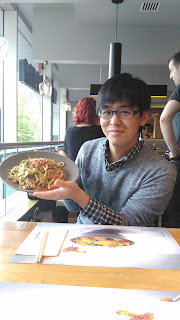Shingo Yoshida, a Japanese PhD student from the University of Tokyo has been surveying farmers in the UK and using some traditional Japanese crafts to improve his success rate.
 I have been an academic visitor at CRE since last October and my research interest is entrepreneurship and farm diversification close to urban areas. In Japan farm diversification is an emerging topic, but there aren’t yet very many farmers who have diversified into new enterprises. So I was interested in entrepreneurial farmers in UK and wanted to carry out some research on this.
I have been an academic visitor at CRE since last October and my research interest is entrepreneurship and farm diversification close to urban areas. In Japan farm diversification is an emerging topic, but there aren’t yet very many farmers who have diversified into new enterprises. So I was interested in entrepreneurial farmers in UK and wanted to carry out some research on this.Since this is the first time I have visited a foreign country as a researcher, I was anxious about whether I could complete my questionnaire survey by myself. But I needn’t have worried. All my colleagues have welcome me warmly and given me lots of helpful advice. Moreover, not only CRE staff, but also other staff in the School of Agriculture, Food and Rural Development have given up their time for me. Thanks to all the help I received, I was able to design the questionnaire in English despite my lack of research experience in the UK.
The most challenging task was to send 1,000 questionnaires out to farmers by post. Since everyone had told me “the rate of return will be low because your questionnaire is quite long for busy farmers to complete”, I made a special effort to interest them. My secret was the Japanese paper craft of ORIGAMI! In Japan, people make ORIGAMI to express our gratitude. So I spent three days and three nights making 1,000 ORIGAMI and enclosed one with each of the questionnaires. I think this was the key to the high return rate of over 20%.
 The results from my research show that it is the entrepreneurship of farmers that promotes farm diversification. Furthermore, diversification into tourism, accommodation facilities and educational enterprises requires additional skills, such as a knowledge of customer relations and marketing. This means that farmers need to improve their generic skills if they want to diversify their farm businesses. This result is also helpful for Japanese agriculture in the future.
The results from my research show that it is the entrepreneurship of farmers that promotes farm diversification. Furthermore, diversification into tourism, accommodation facilities and educational enterprises requires additional skills, such as a knowledge of customer relations and marketing. This means that farmers need to improve their generic skills if they want to diversify their farm businesses. This result is also helpful for Japanese agriculture in the future.When I return to Japan, I’m planning to do the same kind of research. And some day, I would like to come back to Newcastle University to do some collaborative research with my wonderful colleagues here. Finally, I want to say how very much I appreciate Guy Garrod, my supervisor in CRE, inviting me here, to such a beautiful country.

